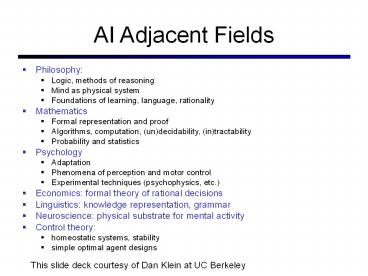CS 294-5: Statistical Natural Language Processing - PowerPoint PPT Presentation
Title:
CS 294-5: Statistical Natural Language Processing
Description:
AI Adjacent Fields Philosophy: Logic, methods of reasoning Mind as physical system Foundations of learning, language, rationality Mathematics Formal representation ... – PowerPoint PPT presentation
Number of Views:110
Avg rating:3.0/5.0
Title: CS 294-5: Statistical Natural Language Processing
1
AI Adjacent Fields
- Philosophy
- Logic, methods of reasoning
- Mind as physical system
- Foundations of learning, language, rationality
- Mathematics
- Formal representation and proof
- Algorithms, computation, (un)decidability,
(in)tractability - Probability and statistics
- Psychology
- Adaptation
- Phenomena of perception and motor control
- Experimental techniques (psychophysics, etc.)?
- Economics formal theory of rational decisions
- Linguistics knowledge representation, grammar
- Neuroscience physical substrate for mental
activity - Control theory
- homeostatic systems, stability
- simple optimal agent designs
This slide deck courtesy of Dan Klein at UC
Berkeley
2
(No Transcript)
3
Reflex Agents
- Reflex agents
- Choose action based on current percept (and maybe
memory)? - May have memory or a model of the worlds current
state - Do not consider the future consequences of their
actions - Act on how the world IS
- Can a reflex agent be rational?
4
Goal Based Agents
- Goal-based agents
- Plan ahead
- Ask what if
- Decisions based on (hypothesized) consequences of
actions - Must have a model of how the world evolves in
response to actions - Act on how the world WOULD BE
5
Search Problems
- A search problem consists of
- A state space
- A transition function
- A start state and a goal test
- A solution is a sequence of actions (a plan)
which transforms the start state to a goal state
N, 1.0
E, 1.0
6
Example Romania
- State space
- Cities
- Transition function
- Go to adj city with cost dist
- Start state
- Arad
- Goal test
- Is state Bucharest?
- Solution?
7
(No Transcript)
8
(No Transcript)
9
Search Trees
E, 1.0
N, 1.0
- A search tree
- This is a what if tree of plans and outcomes
- Start state at the root node
- Children correspond to successors
- Nodes contain states, correspond to PLANS to
those states - For most problems, we can never actually build
the whole tree
10
Another Search Tree
- Search
- Expand out possible plans
- Maintain a fringe of unexpanded plans
- Try to expand as few tree nodes as possible
11
General Tree Search
- Important ideas
- Fringe
- Expansion
- Exploration strategy
- Main question which fringe nodes to explore?
Detailed pseudocode is in the book!
12
(No Transcript)
13
(No Transcript)
14
States vs. Nodes
- Nodes in state space graphs are problem states
- Represent an abstracted state of the world
- Have successors, can be goal / non-goal, have
multiple predecessors - Nodes in search trees are plans
- Represent a plan (sequence of actions) which
results in the nodes state - Have a problem state and one parent, a path
length, a depth a cost - The same problem state may be achieved by
multiple search tree nodes
Search Nodes
Problem States
Parent
Depth 5
Action
Node
Depth 6
15
(No Transcript)
16
(No Transcript)
17
(No Transcript)
18
(No Transcript)
19
(No Transcript)
20
(No Transcript)
21
Comparisons
- When will BFS outperform DFS?
- When will DFS outperform BFS?
22
(No Transcript)
23
(No Transcript)
24
(No Transcript)
25
(No Transcript)
26
(No Transcript)
27
Uniform Cost Search
- What will UCS do for this graph?
- What does this mean for completeness?
b
0
1
0
START
a
1
GOAL
28
Uniform Cost Issues
- Remember explores increasing cost contours
- The good UCS is complete and optimal!
- The bad
- Explores options in every direction
- No information about goal location
c ? 1
c ? 2
c ? 3
Start
Goal
29
(No Transcript)
30
Heuristics
31
Best First / Greedy Search
- Expand the node that seems closest
- What can go wrong?































